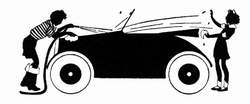Vimeiar and Baking Soda
SCIENTISTS across the globe have studied and debated the concept of acid-base reactions since the 1700s. This chemical reaction can get quite complicated, but it’s easy to understand the basic idea and use your knowledge straightaway for everyday projects. All you need is a stand trip to the supermarket (or your own pantry) for two ingredients: vinegar and baking soda.
ACID-BASE BASICS
Acids corrode and dissolve things. They work by releasing hydrogen bubbles. Vinegar is a medium acid. On the pH scale, which measures the “potential of Hydrogen,” it ranks 3 or 4 on a scale of 1-7.
Bases cancel out acids. Another word to know, science-wise, is alkali, which is a base that can be dissolved in water. Baking soda is a base, or at least it acts like a base, which is good enough for us. Together vinegar and baking soda, acid and base, can tackle many a small task—and some bigger projects, too.
EVERYDAY VINEGAR USES
Vinegar corrodes and dissolves, it has a repellent smell, and it counteracts things that act as a base. Use it to:
Treat skin irritations. Certain itches, like poison ivy and mosquito bites, and pains like jellyfish stings and sunburns, act as bases, so vinegar will counteract them. Mix vinegar half and half with water and spray directly on skin, or soak in towels for compresses. (Apple cider vinegar smells a bit better than white, if you prefer.)
Get rid of rust. Take rusty hand shovels and other items, dip them in a bowl filled with vinegar, and leave overnight. You can do this to shine pennies, too.
Remove sticky goo. For stubborn stickers or the like, soak a cloth in vinegar, then drape it over the sticky area for a few hours.
Repel mosquitos and ants. Apply it to your body with a cotton ball as a mosquito repellent. Leave a cup of it open to persuade ants to camp somewhere other than your family kitchen.
Counteract stink. Put smelly things in a half-andhalf mixture of water and vinegar overnight. Or, if something stinky happens in your family car, leave a bowl of vinegar in there overnight to capture the smell.
EVERYDAY BAKING SODA USES
Baking soda neutralizes acidic things, and can act as an abrasive for scrubbing. You can use it to:
Soothe bee stings. Apply a baking soda and water paste to a bee sting (which acts as an acid) to neutralize it. Now, if your sting is from a wasp or yellow jacket (which actually act as bases), you’ll want to treat those stings with vinegar on a cotton ball.
Remove stains. If you get food coloring on your hands, scrub them with baking soda and water. However, if that food coloring gets onto your clothes, you’ll want to soak those in vinegar.
Calm animal smells. If you’re stink-sprayed by a skunk, mix hydrogen peroxide (available at all pharmacies) with baking soda and some liquid dish soap—that works like a charm. Similarly, if your dog smells, sprinkle her all over with baking soda, rub it in, and brush through her hair.
Brush teeth. Mix baking soda with water into a thick paste (without the unnecessary extras in toothpaste).
Extinguish fires. Baking soda, when heated, emits carbon dioxide, which can smother small flames. That said, if you see fire, shout quickly for the nearest adult, and call 911 immediately.
WASHING THE CAR
You can forgo expensive non-eco-friendly store-bought cleaners for our two wonder products instead.
Before you start washing, sprinkle baking soda through the car’s interior to remove odors. Vacuum it up when the outside washing is done.
For the car body, grab a bucket, and pour in ½ cup of vinegar for every gallon of water; scrub car with a big sponge.
For windows, mirrors, and interior plastic, mix 2 cups of water and ½ cup vinegar in an empty spray bottle. You can add up to ¼ cup of rubbing alcohol and, to make it look fancier, one drop each, no more, of blue and green food coloring. Instead of rags, use newspapers to clean and shine windows.
VOLCANO PROJECT
In an old soda bottle, pour a little more than a ½ cup of vinegar, and a little more than a ½ cup of dishwashing liquid. Add red food coloring, if you wish, for a lava effect.
Make a foundation from a piece of cardboard. Stick the bottle onto that with tape. Then build up a volcano around it. Mound up old newspapers, leaves, or whatever material you have on hand. Once it attains a mountain shape, cover the whole thing with a large sheet of foil, crimping it a bit so it looks volcano-like.
For the eruption, measure 1 heaping tablespoon of baking soda. Wrap it in a small piece of paper towel or pour it straight in. Either way, when you deposit the baking soda, the concoction will erupt before your eyes. It’s very second grade, but always fun, no matter what your age.
Here’s the chemistry behind the volcano: vinegar is acidic acid, baking soda is sodium bicarbonate, a base. When they react together they produce carbonic acid, and that decomposes very quickly into water and carbon dioxide. The foaming bubble explosion is the carbon dioxide gas escaping.
